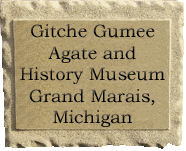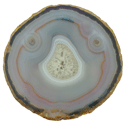MINERAL OF THE MONTH
January 2008: Native Copper
January’s mineral of the month is native copper. This interesting specimen was recently donated to the museum by Peter Pagel, from Marquette. He acquired it from the Houghton area. It is a thick slab of native copper in matrix that is 7 inches by 6 inches.
This specimen was mined from the Keweenaw Peninsula, which is the greatest native copper ore deposit ever found on earth. The deposit formed in the Mid-continent rift zone around a billion years ago. Native Americans have been mining the ore since around 3000 B.C. The first written account of copper was provided by French missionary Claude Allouez in 1667. He recorded that Indians of the Lake Superior region mined copper nuggets in shallow depressions. It was these abandoned pits that led early American prospectors to the sites where successful mines were later established. Large scale mining operations began in 1844 and continued until the 1960s when open pit mining out west became more profitable than underground mining.
The first person to report on the commercial potential of the copper deposit was state geologist, Douglass Houghton, in 1841. The Cliff mine, which was the first copper mine establised in Michigan, began operations in 1845. Copper mining in northern Michigan boomed, and from 1845 until 1887 (when it was exceeded by Butte, Montana) Michigan was the nation's leading producer of copper. In most years from 1850 through 1881, Michigan mined more than three-quarters of the nation's copper, and in 1869 produced more than 95% of the country's copper. Annual production peaked in 1916 at 266 million pounds. Most of the native copper mines shut down in 1968, after producing 11 billion pounds of copper. The White Pine Mine operated until 1995. The only mine still mining copper on a small scale is the Caladonia Mine, located 20 miles northeast of Ontonogon. The mine’s owner, Richard Whiteman, has a worth-the-stop gift shop in Ontonogon called the Gitche Gumee Landing, located at 202 Ontonagon Street, 906-884-6618, www.caledoniamine.com.
The Keeweenaw deposit occurs in an area around 110 miles long, 10 miles wide, and up to a 1,000 feet deep. Throughout this area, there are amgadaloid (basaltic pocket) deposits as well as veins with copper ranging in size from microscopic grains to very large masses of up to around 1,200,000 pounds. Float copper specimens can also be found throughout the Midwest that were scraped free and deposited by Pleistocene glaciers that scoured the Keeweenaw Peninsula during the various ice ages.
One of the most interesting facts about the Keeweenaw copper is that it occurs in a fairly pure metal form called native copper. Most of the other copper deposits in the world form as copper oxides or copper sulfides that require processing to extract the copper.
Copper is a chemical element with the symbol Cu and atomic number 29. It is used extensively as an electrical conductor, heat conductor, building material, and component of various alloys. Copper is a reddish-colored metal that has its characteristic color because of its band structure. In its liquefied state, pure copper appears somewhat greenish, a characteristic shared with gold. When liquid copper is in bright ambient light, it retains some of its pinkish luster.
Civilizations in places such as Iraq, China, Egypt, Greece, India and the Sumerian cities all have early evidence of using copper. A copper pendant was found in northern Iraq that dates to 8700 BC. During the Roman Empire, copper was principally mined on Cyprus, hence the origin of the name of the metal as Cyprium, "metal of Cyprus", later shortened to Cuprum. High demand relative to supply has caused the price of copper to spike during the last few years.
Metaphysical Properties
It has been reported that copper is an excellent conductor that amplifies thoughts, boosts confidence, and facilitates healing. It has been used to treat arthritis as well as other inflammation and circulatory diseases.
Mineral of the Month Archives
May 2007: Rainbow Fluorite
June 2007: Lake Superior Michipicoten Agate
July 2007: Labadorite
August 2007: Rain Flower Agate
Fall 2007: Malachite
December 2007: Nepheline Syenite
January 2008: Native Copper
February 2008: Amazonite
March 2008: Lake Superior Agate
April 2008: Shadow Agate
May 2008: Apohpylite
June 2008: Ocean Jasper
Summer 2008: Marra Mamba Tiger's Eye
September 2008: Mohawkite
October 2008: Mexican opal
November 2008: Prehnite
December 2008: Picture Jasper
January 2009: Sea Shell Jasper
February 2009: Polychrome Jasper
March 2009: Selenite Desert Rose
Spring 2009: Coyamito Agate
July 2009: Obsidian Needles
August 2009: Goethite
September 2009: Banded Iron Formation
Fall 2009: Fairburn Agate
March 2010: Fossilized Dinosaur Bone
April/May: 2010 Kentucky Agate
June 2010: Nantan Meteorite
July 2010: Mookaite Jasper
Aug/Sept 2010: Polyhedroid Agate
Fall 2010: Ammonite Fossil
September 2011: Petoskey Stones
Spring 2011: Petrfied Wood
Winter 2011: Argentina Condor Agate
January 2012: Mary Ellen Jasper
March 2012: Mexican Crazy Lace Agate
June 2012: Moqui Marbles
September 2012: Chlorastrolite Greenstone
March 2013: Jacobsville Sandstone
August 2013: Unakite
November 2013: Skip-an-Atom Agate
April 2014: Tiger's Eye
September 2014: Black Corundum
February 2015: Condor Agate
June 2015: Petoskey Stone
November 2015: Slag
June 2016: Lake Superior Copper Replacement Agates
March 2017: Chert
July 2017: Kona Dolomite
December 2017: Septarian Nodule
Copyright All rights reserved.
Gitche Gumee Museum.
E21739 Brazel Street
Grand Marais, Michigan 49839






